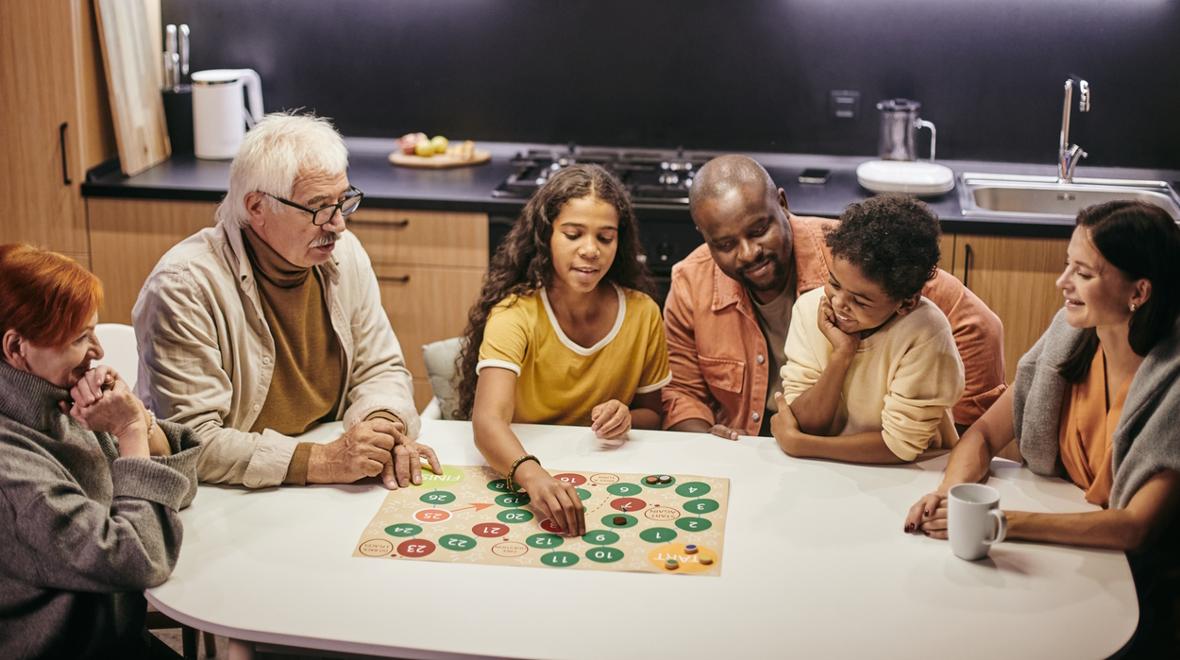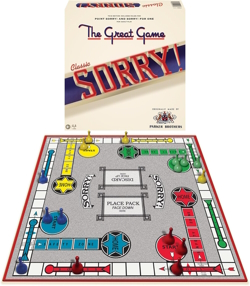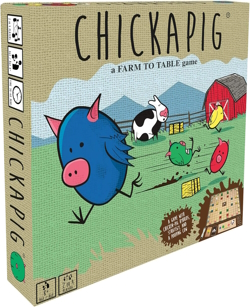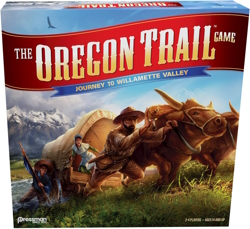
Photo:
iStock
Bringing the family together for game night — what could be simpler? But after years of rolling the same dice or shuffling the same cards, you may be feeling less than inspired. I get it. Here are over 15 parent-tested game picks complete with family-friendly food pairings, plus my top tips to keep the game-night tradition going strong this fall and beyond.
1. Wildcraft

Type: board
Number of players: up to 4
Best for: ages 4 and older
Plan to spend: 45–60 minutes
Pairs with: herbal tea
With the recent surging interest in camping and hiking, parents are fielding more “Hey, what’s this plant?” questions than ever. This simple Chutes and Ladders–style board game teaches kids about plant safety and first aid, and can be enjoyed by pre-readers and adults alike. The game board and box are made with all-recycled materials and printed with vegetable-based inks on Forest Stewardship Council–certified paper. A portion of the proceeds benefit United Plant Savers.
2. Gnomes at Night

Type: board
Number of players: 2–4
Best for: ages 6 and older
Plan to spend: 15 minutes
Pairs with: Bugles corn snacks (aka gnome hats)
Searching for a kid-friendly game that’s more collaborative and less cutthroat? If highly competitive games are too intense for your younger children, check out Gnomes at Night, a cooperative maze game that allows players to work together. The game builds decision-making and communication skills as players team up to maneuver adorable magnetic gnomes through a maze.
3. Sorry Classic Edition

Type: board
Number of players: 2–6
Best for: ages 6 and older
Plan to spend: 30–45 minutes
Pairs with: Twizzlers, Ritz Crackers or Tootsie Pops (all popular 1930s snack foods)
Patented in the 1930s, Sorry is a classic board game that grandparents will remember and kids still love. Players attempt to knock one another out of the game — “Sorry!” (not sorry?) — as they race around the board. The game reinforces sportsmanship and strategy with a fast-moving, familiar feel. The original version has spawned many spin-offs; unlike more modern editions that incorporate electronics, this version of Sorry features classic graphics and is 100 percent unplugged.
4. Labyrinth

Type: board
Number of players: 2–4
Best for: ages 7 and older
Plan to spend: 20–30 minutes
Pairs with: Cheese and crackers cut into squares and arranged on a plate like the game board
This was one of my favorite games when I was little, and my kids love it too. Players take turns changing the maze on the board to try and create a route to the treasure. The changing board makes this game different every time you play, making it easy to play and enjoy for years.
5. Poetry for Neanderthals

Type: card
Number of players: 2–4
Best for: ages 7 and older
Plan to spend: 15 minutes
Pairs with: a try of meat, vegetables, berries, grains and nuts (your standard Neanderthal diet)
Fans of the uproarious Exploding Kittens card game will recognize its signature irreverent illustrations in Poetry for Neanderthals. This competitive word-guessing game takes just a few minutes to learn, so you can spend less time explaining the rules and more time cracking up together. It takes just 15 minutes to play, so you can play multiple rounds or squeeze in a quick game night before tuck-in.
6. King of Tokyo

Type: board
Number of players: 2–6
Best for: ages 8 and older
Plan to spend: 30 minutes
Pairs with: sushi
Play as a monster, robot or alien battling it out as you attempt to gain control of Tokyo. Roll the dice (marked with claws, energy bolts and points rather than just traditional numbers) and do your best to wrestle control of Tokyo from the other players. The game ends when only one monster remains alive or when someone reaches 20 points.
7. Bang!

Type: card
Number of players: 4–7
Best for: ages 8 and older
Plan to spend: 20 to 40 minutes
Pairs with: root beer and a bowl of nuts (or allergen-free alternative)
In this wild west card game, players each have a secret identity and must figure out the identity of the other players to form alliances and defeat foes. The Outlaws hunt the Sheriff. The Sheriff hunts the Outlaws. The Renegade plots secretly, ready to take one side or the other. The action all comes through rolling dice and drawing cards.
8. Chickapig: A Farm to Table Game

Type: board
Number of players: 2–4
Best for: ages 8 and older
Plan to spend: 30–60 minutes
Pairs with: crunchy veggies such as carrots, radishes and sugar snap peas
This classic family board game feels as fresh as farm produce with its simple design, wooden game pieces and organic, folksy appeal. A collaboration between game creator and guitar maker Brian Calhoun (of Rockbridge Guitars) and musician Dave Matthews, this strategy game features fantastical creatures, hay bales and enough manure to keep kids giggling. “Not going to lie, I totally bought it because Dave Matthews is involved,” said Tacoma parent Breeayn Douhit. “Glad I did, though, as it’s surprisingly fun!”
9. Sleeping Queens

Type: card
Number of players: up to 5
Best for: ages 8 and older
Plan to spend: 20 minutes
Pairs with: milk and cookies
When it’s been a long week and you’re beat, remember that family game night doesn’t need to last for hours or drain every last bit of your energy. Sleeping Queens is a blessedly brief card game for the grade-school set that was invented by an imaginative 6-year-old. Play multiple rounds for a longer game night or keep the evening short and sweet with a single 20-minute session.
10. What Do You Meme? Family Edition

Type: card
Number of players: 4–8
Best for: ages 8 and older
Plan to spend: 30–60 minutes
Pairs with: hot cocoa bombs or another Instagram-worthy snack
Having trouble finding a game even hard-to-please teens will love? Entice reluctant game-nighters back to the table with this sidesplitting family edition of the popular What Do You Meme? party game. Players use 300 caption cards and 65 photo cards to create the funniest memes, as decided by a rotating judge. Simple enough to play after a tiring day of work and/or school, this affordable game deserves a spot in your feed (or game cabinet).
11. Ticket to Ride

Type: board
Number of players: 2–5
Best for: ages 8 and older
Plan to spend: 30–60 minutes
Pairs with: classic travel snacks (pretzels, peanuts and popcorn)
Kids who are outgrowing their childhood train set — or adults who never did — will love Ticket to Ride, a route-building strategy game on rails. The game takes players on a cross-country train adventure, on which longer routes equal more points. Devoted riders can add to their collections with the USA 1910 expansion set or the Ticket to Ride Europe edition.
12. Daybreak

Type: board
Number of players: 1–4
Best for: and 10 and older
Plan to spend: 60–90 minutes
Pairs with: locally grown goodies from your neighborhood farmers market
From the creators of the popular game Pandemic, comes this new cooperative board game about climate action. Each player controls a world power and using policies and technologies, works to stop global heating and build resilient societies. But, if the global temperature gets too high or any one power has too many people in crisis, everyone loses. Never fear! If you work together to draw down global emissions, you all win! These games can be a bit complex and take some time, so make sure your gaming crew is ready and in for the long haul.
13. Root

Type: board
Number of players: 2–4
Best for: 10 and older
Plan to spend: 60–90 minutes
Pairs with: a big bowl of trail mix
If you have a true gamer in your family who loves complex strategy games, this one is for you. Each player controls a different faction of woodland creatures and is competing for control of the forest. Each faction has its own strengths and strategy and method of play, making this game complicated, but also gives it high levels of re-playability (it will be different every time you play). Full disclosure — I am not the super-gamer in my family, and I have never really understood what is going on when we play this game. But, my son has loved it since he was 12 years old and sometimes takes out the gigantic instruction manual and reads it for fun. If that sounds like your idea of fun too, then you will love this award-winning, beautifully illustrated game.
14. Munchkin

Type: board
Number of players: 3–6
Best for: ages 10 and older
Plan to spend: 60+ minutes
Pairs with: monster cookies
This game’s tag line says it all: “Kill the monsters, steal the treasure, stab your buddy.” Players move their way through a dungeon encountering monsters along the way. Will you fight the monster or try and run away? You can ask your fellow adventures for help, but look out! Players can help you fight a monster to share in the loot, or they can help the monster and try and knock you out of the game! This game is a favorite of both my tweens, and many of their friends.
15. Trekking the National Parks

Type: board
Number of players: up to 5
Best for: ages 10 and older
Plan to spend: 30–60 minutes
Pairs with: huckleberry ice cream
Dreaming of a national park trip, or wanting to relive memories from your last adventure? Trekking the National Parks takes players across the continent to set up camp and claim “victory points” at American national parks. While this award-winning game comes in on the pricier side, a portion of the proceeds support the National Parks Foundation.
16. Splendor

Type: card and token
Number of players: 2–4
Best for: ages 10 and older
Plan to spend: 30 minutes
Pairs with: jewel-tone gummies
School-age kids who love Minecraft or simply appreciate a well-crafted strategy game will enjoy Splendor. Players are merchants attempting to build a collection of gem mines and shops by collecting jewel-tone chips to acquire points. The game has a historical feel without a complicated narrative, so families can easily enjoy it over and over again.
17. Kids Against Maturity

Type: card
Number of players: 4–8
Best for: ages 10 and older
Plan to spend: 30–90 minutes
Pairs with: kid-friendly snacks, from fruit roll-ups to cheese and crackers
If you want to share the hilarity of the wildly popular Cards Against Humanity (CAH) game with your kids but can’t quite make peace with its famously R-rated content, look no further. Aimed at kids who are outgrowing the much tamer Apples to Apples game but aren’t ready for CAH, Kids Against Maturity is suited for family play. Players combine words and phrases to uproarious effect, with plenty of silliness and potty-themed humor to keep kids completely entertained.
18. Ecologies

Type: card
Number of players: up to 6
Best for: ages 12 and older
Plan to spend: 60–90 minutes
Pairs with: locally grown produce and a healthy dip
Created by a biology instructor, Ecologies is a beautifully illustrated card game that’s educational enough to feel enriching — it’s been used as a teaching tool in science classrooms — with a healthy dose of competitive strategy thrown in. Players build and nurture their own food systems in biomes around the world and decide whether to disrupt their opponents’ ecosystems. But much like real-world food webs, sustainability isn’t something you achieve alone; trading with other players helps the game feel more collaborative.
19. Wingspan

Type: board
Number of players: 1–5
Best for: ages 14 and older
Plan to spend: 40 to 60+ minutes
Pairs with: nuts (or allergen-free alternative), seeds and dried berries
This game is a relaxing strategy game, with beautiful art. Each player is a bird enthusiast (researchers, bird watchers, ornithologists and collectors) trying to attract unique birds to their aviary to earn points. The player with the highest score after four rounds wins. There is even a dice tower that looks like a bird house to add to the fun. This game is a bit complex and can take a while to complete, so it’s best for the tween and older crowd. Of course, younger kids with a knack for strategy and patience for a longer game will enjoy it as well.
20. The Oregon Trail Game: Journey to Willamette Valley

Type: board
Number of players: up to 4
Best for: ages 14 and older
Plan to spend: 60+ minutes
Pairs with: trail mix
If the idea of loading up a covered wagon for a perilous journey west seems familiar, it should: The Oregon Trail Game is based on the iconic Oregon Trail computer game many parents (raising hand) played as kids. This updated version — no screens required — sends players on a similar westward journey as they hunt for food, manage limited wagon space and fend off threats, from disease to animal attacks. Enjoy swimming in nostalgia — just watch out for drowning hazards.
Bonus: Ask an expert
Still looking for more ideas? Check out Mox Boarding House. Staff always have great recommendations (locations in Seattle, Bellevue and Portland) to meet the needs of any game night. The website also allows you to search the inventory of games using filters to help you find just the right match.
Tips to take game night over the topDon’t be daunted by age limits: Younger players can enjoy games aimed at older players by adjusting the rules or teaming up with a parent. Keep it fresh: Minimize grumbles and eye-rolling from older children by establishing a fair system for choosing the night’s game. Players can roll a die (highest roll chooses the game) or simply rotate through family members to take turns picking a game. Set a time limit: If family game nights tend to end in tears or frustration, set a time limit and look for games that won’t test family members’ patience or attention span. Games that take longer than one hour are best for kids ages 10 and older, while those with a 30- to 45-minute playing time would suit players ages 6–10. Take a break from the table: The kitchen table isn’t the only spot for family game play. Depending on the game, you can play anywhere you’d like as long as you have a flat surface. Invest in a puzzle board so you can move your game to the family room, rec room or even the floor. Ban phones: Nothing kills the family-game-night vibe faster than one or more players answering texts or multitasking on their phones. Establish a no-phones rule during game play and collect the devices in a box before the game begins. If teens (or grown-ups) protest, a quick midsession break allows players to check messages before resuming game play. Look for a video tutorial: For new games or those with complicated rules, the quickest route to an unplugged game night may be viewing a short video tutorial beforehand. When at least one player has a good grasp of the rules, you’ll avoid the need to search for answers on your phone, and everyone can stay engaged in the game. Brighten those bulbs: Don’t make eyestrain part of game night. Most games come with instructions in tiny print, so choose a spot with ample, bright lighting. Upgrading to energy-efficient LED bulbs or adding task lighting may be the easiest way to make game night more accessible and inclusive for multiple generations. Serve easy, mess-free finger foods: Snacks can help keep kids’ energy up and ward off blood-sugar crashes, but nobody wants their favorite game covered in greasy fingerprints. Having snacks, napkins and hand wipes at the ready helps keep everyone fed and clean. |
Editor’s note: This article was originally published several years ago, and was most recently updated in August 2024 by associate editor Kari Hanson with a new game and fact-check on all other card and board games.
This article contains affiliate links. If you purchase products through links on our site, ParentMap may earn a commission.











